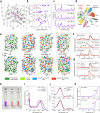Engineering of soluble bacteriorhodopsin
- PMID: 40406218
- PMCID: PMC12094106
- DOI: 10.1039/d5sc02453f
Engineering of soluble bacteriorhodopsin
Abstract
Studies and applications of membrane proteins remain challenging due to the requirement of maintaining them in a lipid membrane or a membrane mimic. Modern machine learning-based protein engineering methods offer a possibility of generating soluble analogs of membrane proteins that retain the active site structure and ligand-binding properties; however, clear examples are currently missing. Here, we report successful engineering of proteins dubbed NeuroBRs that mimic the active site (retinal-binding pocket) of bacteriorhodopsin, a light-driven proton pump and well-studied model membrane protein. NeuroBRs are soluble and stable, bind retinal and exhibit photocycles under illumination. The crystallographic structure of NeuroBR_A, determined at anisotropic resolution reaching 1.76 Å, reveals an excellently conserved chromophore binding pocket and tertiary structure. Thus, NeuroBRs are promising microbial rhodopsin mimics for studying retinal photochemistry and potential soluble effector modules for optogenetic tools. Overall, our results highlight the power of modern protein engineering approaches and pave the way towards wider development of molecular tools derived from membrane proteins.
This journal is © The Royal Society of Chemistry.
Conflict of interest statement
The authors declare no competing interests.
Figures



References
LinkOut - more resources
Full Text Sources

